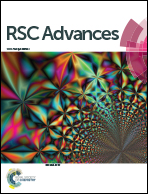Surface morphology of electrospun PLA fibers: mechanisms of pore formation
Abstract
The article elucidates the mechanisms of formation of varying degrees of surface pores/pits on polylactic acid (PLA) fibers during electrospinning. The role of a combination of different parameters in governing pore formation was demonstrated. They include solvent vapor pressure (pv), solvent miscibility/interaction with water, solubility parameter, and relative humidity (RH) within the spinning unit. Our results indicated that traditional mechanisms like thermally induced phase separation (TIPS) and vapor induced phase separation (VIPS) were not responsible in the generation of surface porosity/pits. Instead, higher RH (water vapor, a non-solvent of the polymer), and its miscibility/interaction with solvent(s) were concluded to be relatively more important than the simple presence of a high pv solvent or a combination of high pv and low pv solvent system. Further, content of high pv solvent in solution determined the spherical or elliptical nature of pores/pits by affecting the level of saturation of nearby region of the interface between jet and air during the electrospinning process.


 Please wait while we load your content...
Please wait while we load your content...